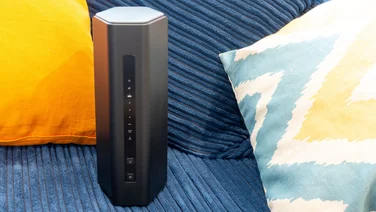To help us provide you with free impartial advice, we may earn a commission if you buy through links on our site. Learn more

- Decent coverage
- Compact design
- WPS button
- Basic feature set
- No USP
Early Christmas deal: Big savings on a D-Link WiFi system
The D-Link Cover C1203 has been reduced in time for Christmas. Previously £218 on Amazon, the WiFi system is now £92. That's an incredible saving of better than half price!
£92
Amazon
D-Link has an extensive portfolio of routers, but it’s held back from releasing a domestic wireless mesh system – until now. The three-node Covr C1203 kit is designed to propagate Wi-Fi all around your home, in exactly the same way as existing products from the likes of Linksys, Netgear and TP-Link. The question is, in an increasingly crowded market, does this newcomer have what it takes to compete with the established market leaders?
READ NEXT: Best mesh Wi-Fi routers
D-Link Covr C1203 review: What you need to know
The Covr C1203 is a mesh networking system that, as usual, is designed to replace your existing router. The kit contains three compact nodes, measuring 109 x 117 x 51mm, promising a total wireless coverage of up to 465m2; there’s also a C1202 twin-pack available, although D-Link doesn’t advertise a claimed coverage area for a pair of nodes.
The nodes are 802.11ac certified and support MU-MIMO, with each one containing a 300Mbits/sec 2.4GHz radio, plus a 5GHz radio rated at up to 866Mbits/sec. There’s no separate third radio for backhaul traffic, however, so some of the available bandwidth will be eaten up by the nodes talking to each other. At the rear of each unit there’s a pair of Gigabit Ethernet sockets, plus a handy WPS button to help you easily add devices to the wireless network.
D-Link Covr C1203 review: Price and competition

You’ll pay £210 for the three-node Covr kit, which puts it squarely in the middle of the mesh market. Just above it, price-wise, sit Netgear’s Orbi RBK20 and Linksys’ Velop Dual Band triple-pack – a likeable system, if not the fastest about.
On the cheaper side, for £195 you can get the three-node TP-Link Deco M5 system – again not an outstanding performer, but a solid system with the advantage of built-in security features. Or, if you’re not bothered about features, you can now get a set of three BT Whole Home Wi-Fi discs for just £170. These attach to your existing router, rather than replacing it, but performance is excellent and the price is hard to quibble with.
D-Link Covr C1203 review: Setup and features

The Covr units come pre-paired, and they have QR codes printed on the bottom, which you can scan with your smartphone to immediately register them with the D-Link smartphone app. This makes initial setup supremely easy.
After that strong start, however, I found the rest of the process rather frustrating. Updating and configuring the primary node was slow, and the setup wizard seemed to forget about the two satellite nodes – I had to dig into the app to see whether they were connected – and to install the latest firmware I had to trigger the update manually on each one in turn. Still, this is something you’ll only go through once in a blue moon.
Indeed, once you’re set up you probably won’t have much reason to use the app at all – and you can count yourself lucky, as it’s hardly a great experience. It’s fiddly to get around, and offers precious little in the way of administrative features: you can block individual clients, set up access schedules and enable a guest Wi-Fi network, but that’s more or less it.
Thankfully, the Covr also offers a web portal, which is richer and more logically laid out. Here you can change the Covr’s DHCP settings, set up firewall and port-forwarding rules, apply network-wide website blacklisting (although a maximum of 24 URLs can be barred) and enable DynDNS or D-Link’s own DLinkDDNS.com service. It’s not exactly an extensive feature set though, and there’s no access point mode for those who want (or need) to keep using their existing router.
READ NEXT: Best wireless routers
D-Link Covr C1203 review: Performance

The Covr nodes are quite dinky, and they contain three antennae each. That isn’t a lot by mesh standards – for comparison, the TP-Link Deco M9 Plus units have eight apiece – and that often has implications for performance. What’s more, as I mentioned above, there’s no dedicated backhaul radio, so I was interested to see how the Covr network would perform.
To test it, I spread the three nodes out across the length of the ground floor of my home (the web portal confirmed that signal strength was “Excellent” to one and “Good” to the other), then measured wireless file-copy speeds as I read and wrote a series of 100MB files to a NAS drive connected to the primary Covr unit via Gigabit Ethernet.
The results weren’t bad at all. In the living room, I saw read and write speeds of 21MB/sec and 16MB/sec respectively. In the upstairs bedroom these fell to 17MB/sec and 7MB/sec; and even in the bathroom at the back of the house – ordinarily a “not-spot” owing to its distance from the living room – I got read speeds of 8MB/sec and write speeds of 6MB/sec. If you’re looking for a mesh system to extend internet coverage to the far reaches of your home, the Covr will certainly do the job.
That said, there are certainly faster options out there. The similarly priced Netgear Orbi RBK20 gave me 14MB/sec in the bathroom, while the premium TP-Link Deco M9 Plus kept up a blazing 19MB/sec. Even the cheaper BT Whole Home Wi-Fi system served up 13MB/sec to the same location. For a bigger property, or for a home-office scenario where you frequently move large files around, the difference could be significant.
D-Link Covr C1203 review: Verdict
D-Link’s first bash at a whole-home Wi-Fi system performs respectably enough, but if speed is your priority then you’ll probably be better off with one of the Covr’s established rivals. Nor is this the cheapest three-node system out there – and based on our experiences with the app we can’t recommend it as a particularly user-friendly or feature-packed option either.
Ultimately there’s nothing wrong with the Covr mesh kit, but if it’s to stand out from the crowd it really wants either a price cut or a significant software upgrade. As things stand it’s a mediocre performer at a mid-range price.








